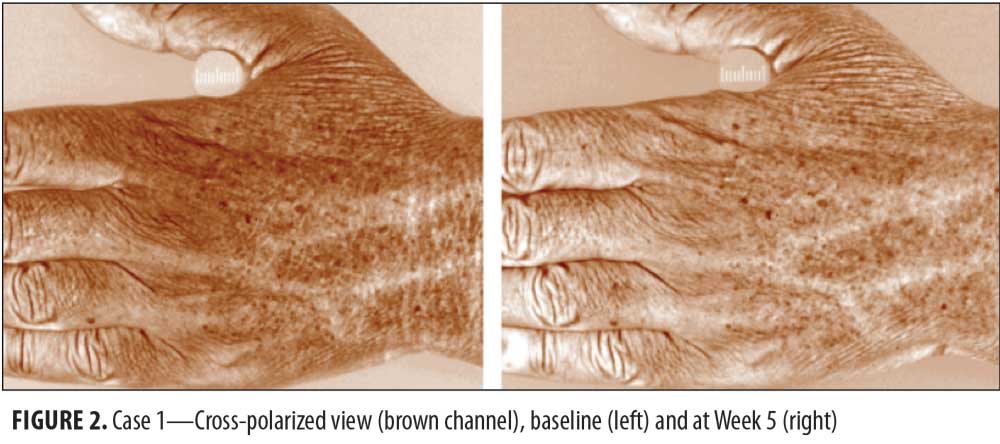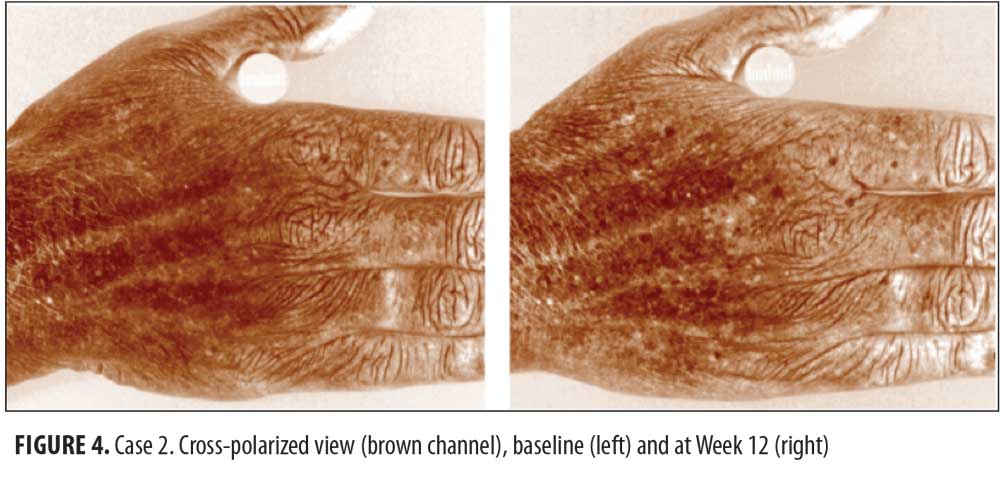 by Wendy E. Roberts, MD; Lora Colvan, BS; and Vincent Gotz, MS Pharm
by Wendy E. Roberts, MD; Lora Colvan, BS; and Vincent Gotz, MS Pharm
Dr. Roberts is with Generational and Cosmetic Dermatology, Rancho Mirage, California, and Ms. Colvan and Mr. Gotz are with MDRejuvena, Inc., Carlsbad, California.
J Clin Aesthet Dermatol. 2017;10(8):37–41
Funding: No funding was provided for this study.
Disclosures: Dr. Roberts has no conflicts of interest relevant to the contents of this article. Ms. Colvan and Mr. Gotz have stock options in MDRejuvena, Inc. and were both employed by MDRejuvena, Inc. at the time of this study.
Keywords: Aging hands, hand rejuvenation, photodamage, sodium copper chlorophyllin, urea
Abstract: Rejuvenation of aging hands is becoming increasingly important to physicians and their patients. While a variety of invasive treatments are available, topical products that improve manifestations of aging hands are needed. In this brief report, the efficacy of a topical product containing urea, lipids, sodium copper chlorophyllin complex, antioxidants, and humectants was assessed in subjects with moderate-to-severe photodamage of the hands.
Introduction
Traditionally, topical skin rejuvenating treatments have focused on the face, while other visible parts of the body have largely been neglected. More recently, the aging hand has become an area of increasing interest to aesthetic physicians and their patients. Hands, which are prominently visible to the individual and to those with whom the individual interacts, are important in human interactions and nonverbal communications.[1–3] Hand appearance has been shown to impact perceived age.[4] As such, individuals are becoming increasingly cognizant of the appearance of their hands.
The dorsal parts of the hand are most adversely affected by exposure to ultraviolet (UV) radiation. With aging, dermal collagen, elastin, and glycosaminoglycans are altered, resulting in skin laxity and thinning. Epidermal thinning along with atrophy of subcutaneous fat causes veins, underlying tendons, and bony structures to become more visible in aged skin. Additional clinical manifestations of the aging hand include textural roughness, dyschromia, lentigines, seborrheic and/or actinic keratosis, and wrinkling.[5–8] Traditional treatments to rejuvenate aged hands include lasers, intense light sources, chemical peels, sclerotherapy, dermal fillers/fat augmentation, and topical skin care products.[6–10]
Sodium copper chlorophyllin complex (CHLcu) has been shown to have several therapeutic properties in vitro, including antioxidant, anti-inflammatory, and antibacterial properties and inhibition of hyaluronidase.[11–15] In addition, topical application of very low concentrations of this active ingredient (0.025–0.1%) has been shown to have clinically beneficial effects on facial photodamage, redness, enlarged pores, and acne.[16–18] Recently, in a human biopsy study, CHLcu demonstrated the ability to repair photodamaged skin by stimulation of biomarkers in the human extracellular matrix.[19]
A topical formulation of liposomal CHLcu, urea, lipids, antioxidants, and humectants has been developed as a treatment to enhance skin texture, moisturize, and improve skin barrier function and signs of photodamaged skin. The product (Rejuvaphyl® Hand and Neck Complex, MDRejuvena, Inc., Carlsbad, California) was applied twice daily in eight subjects (aged 54–70 years) with moderate to severe photodamage of the hands to assess its ability to reduce signs of photoaging. Treatment was up to 14 weeks depending upon response. The only other product that was used on the hands was a sun protection factor (SPF) 30 sunscreen. The cases in this brief report include both clinical evaluations and standardized digital photography, and demonstrate a potential novel approach to improving the aesthetics of aging hands.
Cases
Case 1. Case 1 was a 62-year-old woman with moderate photodamage of the hands treated for five weeks (Figures 1 and 2, Table 1).



Case 2. Case 2 was a 59-year-old woman with severe photodamage of the hands treated for 12 weeks (Figures 3 and 4, Table 2).



Case 3. Case 3 was a 60-year-old woman with moderate photodamage of the hands treated for 12 weeks (Figures 5 and 6, Table 3).



Case 4. Case 4 was a 64-year-old woman with moderate photodamage of the hands treated for 11 weeks (Figures 7 and 8, Table 4).



Discussion
There has been a huge growth in topical facial rejuvenation treatment products over the past decade. Until recently, however, readily visible areas of the body, other than the face, have been largely neglected. The appearance of the hands, which impacts the perceived age of the individual,[3,4] is becoming an area of increasing interest with physicians and patients alike.
Topical urea has a long history of use in dermatology. It is one of the key components in natural moisturizing factor (NMF) of the stratum corneum.[20] Urea readily decomposes to yield ammonium ions and cyanate, which undergo further conversion to carbon dioxide and ammonia.[21] The hand product formulation utilized in the presented cases employs a stabilized form of urea in high concentrations (hydroxyethyl urea 25%) and a vegetable-derived, skin-identical lipid concentrate featuring a combination of three ceramides (1, 3, and 6), cholesterol, free fatty acids, and phytosphingosine. The formulation also employs a liposomal CHLcu, which has been shown in previous studies to decrease clinical signs of facial photodamage[16] and to repair photoaged skin by stimulating biomarkers in the extracellular matrix.[19]
The cases presented in this brief report show improvements in photodamaged skin on the hands, namely fine lines/wrinkles, tactile roughness, skin tone unevenness, and mottled pigmentation. The skin assessment summary for all eight subjects (Table 5) shows mean improvements in various photodamage parameters. Global improvement (which was based on a combination of photographic assessment and visual clinical evaluation) was rated as moderate improvement for all eight subjects.

Controlled, randomized studies evaluating the effectiveness of CHLcu combined with urea, lipids, antioxidants, and humectants (Rejuvaphyl® Hand and Neck Complex) in reducing signs of photoaging are needed before meaningful conclusions can be drawn. However, our preliminary results suggest this combination therapy has potential as a rejuvenation treatment.
References
- Jakubietz RG, Jakubietz MG, Kloss D, Gruenert JG. Defining the basic aesthetics of the hand. Aesthetic Plast Surg. 2005;29:546–551.
- Jakubietz RG, Kloss DF, Gruenert JG, Jakubietz MG. The aging hand. A study to evaluate the chronological ageing process of the hand. J Plast Reconstr Aesthet Surg. 2008;61:681–686.
- Koscinski K. Hand attractiveness-its determinants and association with facial attractiveness. Behav Ecol. 2012;23:334–342.
- Bains RD, Thorpe H, Southern S. Hand aging: patient’s opinions. Plast Reconstr Surg. 2006;117:2212–2218.
- Fenske NA, Lober CW. Structural and functional changes of normal aging skin. J Am Acad Dermatol. 1986;15:571–585.
- Shamban AT. Combination hand rejuvenation procedures. Aesth Surg J. 2009;29:409–413.
- Fabi SG, Goldman MP. Hand rejuvenation: a review and our experience. Dermatol Surg. 2012:38:1112–1127.
- Butterwick KJ. Rejuvenation of the aging hand. Dermatol Clin. 2005;23:515–527.9. Gold MH, Gallagher C. An evaluation of the benefits of a topical treatment in the improvement of photodamaged hands with age spots, freckles, and/or discolorations. J Drug Dermatol. 2013;12:1468–1472.
- Schlessinger J, Saxena S, Mohr S. Assessment of a novel anti-aging hand cream. J Drugs Dermatol. 2016;15:496–503.
- Brett DW. Chlorophyllin-a healer? A hypothesis for its activity. Wounds. 2005;17:190–195.12. Tumolo T, Lanfer-Marquez UM. Copper chlorophyllin: a food colorant with bioactive properties? Food Res Int. 2012;46:451–459.
- Kamat JP, Boloor KK, Devasagayam TPA. Chlorophyllin as an effective antioxidant against membrane damage in vitro and ex vivo. Biochimica et Biophysica Acta. 2000;1487:113–127.
- Lopez-Carballo G, Hernandez-Munoz P, Gavara R, Ocio MJ. Photoactiviated chlorophyllin-based gelatin films and coatings to prevent microbial contamination of food products. Int J Food Microbiol. 2008;126:65–70.
- McCook JP, Dorogi PL, Vasily DB, Cefalo DR. In vitro inhibition of hyaluronidase by sodium copper chlorophyllin and chlorophyllin analogs. Clin Cosmet Invest Dermatol. 2015;8:443–448.
- Sigler ML, Stephens TJ. Assessment of the safety and efficacy of topical chlorophyllin in women with photodamaged facial skin. J Drugs Dermatol. 2015;14:401–404.
- Vasily DB. Topical treatment with liposomal sodium copper chlorophyllin complex in subjects with facial redness and erythematotelangiectatic rosacea: case studies. J Drug Dermatol. 2015;14:1157–1159.
- Stephens TJ, McCook JP, Herndon JH. Pilot study of copper chlorophyllin complex in subjects with facial acne and large pores. J Drugs Dermatol. 2015;14:589–592.
- McCook JP, Stephens TJ, Jiang L, et al. Ability of sodium copper chlorophyllin complex to repair photoaged skin by stimulation of biomarkers in human extracellular matrix. Clin Cosmet Invest Dermatol. 2016;9:167–174.
- Friedman AJ, von Grote EC, Meckfessel MH. Urea: a clinically oriented overview from bench to bedside. J Drugs Dermatol. 2016;15:633–639.
- Panyachariwat N, Steckel H. Stability of urea in solution and pharmaceutical preparations. J Cosmet Sci. 2014;65:187–195.

